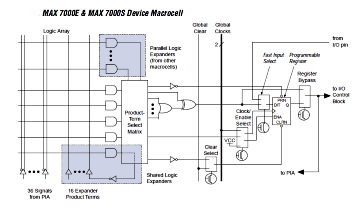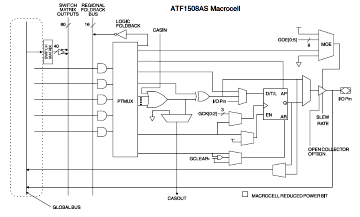|
"MTX Plus+" CPU Board -
CPLD Comparison
As the amount of logic in the MTXPlus+ CPU CPLD expanded to
support additional features of the system, the CPLD's resources
became an issue. In the first instance, the quantity of
available logic resources, i.e., the number of macrocells (128)
in the Altera EPM7128S appeared to be the limiting factor.
There was a relatively easy solution to this, Lez had also
obtained a couple of the next size up Altera CPLDs for me - the
EPM7160S (160 macrocells). The 7160 is pin-compatible with the
7128, with the exception that 4 fewer I/O pins are available.
With some slight modification to the CPU board design, such as
removing the external Page Port signals from the CPLD and using
a 74HCT273 instead, some relocation of CPLD I/O would have
allowed the additional logic to fit into the larger CPLD.
However, the design continued to develop and the reduced
number of I/O pins in the 7160 then became a limiting factor. It
would not have been possible to fit in all of the desired
functions into either the 7128 (macrocell constrained) or 7160
devices (I/O constrained).
Tony did some research and identified a possible solution by
replacing the Altera EPM7128S with an Atmel ATF1508AS.
The Atmel website
provides a high level summary of the
ATF15xx series features :
Atmel CPLDs: Industry Compatible
The ATF15xxAS/ASL/ASV/ASVL CPLD family offers
pin-compatible supersets of the popular Altera 7000 and
3000 series devices ranging from 32 to 128 macrocells
with propagation delays from 7.5 to 15 ns for 5V
standard power versions and 15 ns for 3.3V versions. All
devices also support JTAG in-system programming (ISP).
The Logic Doubling™ features of the ATF15xx
family make these products ideal for new designs. The
ATF15xx family offers the most powerful switch matrix
and routing resources of any CPLD while also supporting
multiple independent feedbacks, individual output
enable, global clear and D/T/latch configurable
flip-flops. More global clock pins, a programmable
pin-keeper and the ability to realize two latches per
macrocell are further examples of the enhanced features
available from this CPLD product family. |
Of course, as would be expected, Altera assert that the Atmel
device is not equivalent to their device and produced an
Analysis Report (M-WP-ATF1500-1,
September 1998) justifying their conclusions :
| "The test results show that ATF1508AS devices are
not equivalent to EPM7128S devices. The Atmel
devices have slower timing characteristics (which caused
problems for both synchronous and asynchronous circuits)
and different data sheet parameters than Altera devices.
Additionally, they consume up to four times more current
than Altera devices, which causes the Atmel devices to
exceed thermal reliability limits at certain
frequencies. This increase in power consumption could be
attributed to the fact that the ATF1508AS die size is
twice as large as the EPM7128S die. Lastly, the Atmel
devices do not support ISP in manufacturing environments
with in-circuit testers." |
For use in MTXPlus+, the importance difference between the
two devices is the Logic Doubling™ feature of the Atmel device,
described in detail in an Atmel White Paper (2310A–03/01).
The paper describes how I/O pin to logic cell connectivity
differs between CPLDs and smaller PLDs such as PALs and GALs. In
the smaller devices, all I/O pins are fully connected to all
logic cells. However, as the number of macrocells in a CPLD
increases, the required dye area required to maintain full
connectivity becomes prohibitive and macrocells are typically
grouped into blocks (LABs) which have full connectivity to a
subset of the I/O and limited connectivity with the rest.
When designing the ATF series, Atmel endeavored to retain as
much I/O connectivity and logic reusability as possible, and in
the ATF 1502, 100% connectivity is maintained. The Global bus in
the ATF1500 has all input and feedback signals available to all
logic blocks, In the larger devices in the series, i.e., the
1504 and 1508, 100% connectivity is not achieved and these
devices use the global/regional bus hierarchy for cross-point
allocation. "Even so, Atmel’s CPLDs maintain the highest
connectivity of any CPLD Family."
|
Altera vs. Atmel Macrocell Comparison |
 |
 |
| Altera EPM7128SLC84-10 |
Atmel ATF1508AS-10JU84 |
The macrocell schematics from the Altera and Atmel datasheets
help explain the differences between the two devices.
Each macrocell in the Altera device
consists of three functional blocks :
|
| the
logic array |
Combinatorial logic is implemented in the logic
array, which provides five product terms per macrocell.
|
|
the product term select matrix |
Allocates the product terms for
use as either primary logic inputs to the OR and XOR
gates to implement combinatorial functions, or |
| the programmable
register |
Allocates the product terms as secondary inputs to
the macrocell's register clear, preset, clock and clock
enable control functions |
In addition to the directly accessible I/O (7 or 8 pins),
each macrocell in the Altera device has 36 connections to the
Programmable Interconnect Array (PIA).
The Atmel device has the same number of directly connected I/O,
but has 40 connections to Atmel's equivalent of the PIA - the
Global Bus.
Each LAB in the Altera device has 16 Shared Logic
Expanders that can be viewed as a pool of
uncommitted single product terms (one from each macrocell) that
feed back into the logic array. These expanders are referred to
as Foldback Terms in the Atmel
datasheet and shown connected to the Regional
Foldback Bus, again, there is 1
Foldback / Shared Expander
term per macrocell.
The Altera macrocell schematic shows Parallel
Logic Expanders, these are unused product terms
that can be allocated to a neighboring macrocell to implement
complex logic functions. Parallel expanders allow up to 20
product terms to directly feed the macrocell OR logic, with 5
product terms coming from the macrocell and the other 15 being
provided by neighboring macrocells in the LAB. The Atmel
datasheet refers to Parallel Expanders
as Cascade Logic terms, with
CASIN and CASOUT
signals connecting to neighboring macrocells in the LAB. Using
CASIN, the Atmel device allows up to
40 product terms to feed the OR logic.
The Atmel macrocell has an enhancement over the Altera
device, there is an additional buried feedback signal that goes
to the Global bus. The extra buried signal can be either
combinatorial or registered, regardless of whether the macocell
output is combinatorial or registered. Feedback of a buried
combinatorial output allows the creation of a second latch
within a macrocell.
|
Feature Comparison |
| |
Altera EPM7128SLC84-10 |
Atmel ATF1508AS-10JU84 |
| Cost (Mouser UK, ex. VAT) |
£23.42 |
£8.93 |
| Propagation Delay (ns) |
6 |
10 |
| Maximum Frequency (MHz) |
147.1 |
125 |
| Useable Gates |
2500 |
3000 |
| Macrocells |
128 |
128 |
| Logic Array Blocks |
8 |
8 |
| Signal Pins |
68 |
68 |
| User I/O Pins (If JTag Used) |
64 |
64 |
| I/O Pins per macrocell |
6 to 16 |
8 to 12 |
| Logic Outputs per macrocell |
16 (to PIA) |
16 (to Global bus) |
| Internal CPLD Macrocell inputs |
36 (from PIS) |
(40 from Global bus) |
| Global Clock Inputs |
2 |
3 |
| Global Clear Inputs |
1 |
1 |
|
EDA Software |
Altera Quartus II 13.0SP1 |
Atmel ProChip Designer 5.0 |
| License Cost |
free |
$499 (2 year license) |
| Basic logic compiler |
n/a |
WinCUPL |
| License Cost |
n/a |
free |
Notional cost per device, based
on 1 device with EDA tools |
£23.42 |
£365.93 |
Notional cost per device, based
on 10 devices with EDA tools |
£23.42 |
£44.63 |
Notional cost per device, based
on 100 devices with EDA tools |
£23.42 |
£12.50 |
For incorporating a CPLD application in a commercial product,
it is clear that, from a cost perspective, the Atmel device
would work out significantly cheaper, even after paying for a
ProChip Designer license. For a small hobbyist project that
might generate a limited number of sales, the Altera device
works out cheaper - the break point after which the Atmel cost
starts to reduce below the Altera cost is ~25 devices.
If the designer just wants to use very basic logic functions
and is happy to program the device using boolean expressions,
then the Atmel device may be preferable for small scale products
too. On the other hand, if the designer wants to be able to use
a fully featured
Electronic Design Automation suite, with a full range of
simulation features and complex function blocks, then the Altera
device is likely the most appropriate choice.
For MTXPlus+, I had hoped to replace the Altera device with the Atmel
one to resolve the specific issues with the CPU board CPLD, but
continue to use the Altera devices for other CPLD
applications because of the availability of Quartus II. However,
as I could not justify the cost of the ProChip Designer License
until I knew for certain that I could "productise" MTXPlus+,
then I could not synthsise and simulate the CPLD logic, so I
will have to stick with the EPM7128S and thought that I would
need to find another solution
to the resource issue on the CPU board.
As it turns out though, Tony has significantly optimised the
Speculator+ design - as we as my bloated clock generation logic
and the complete MTXPlus+ design will now fit into the 7128.
Removing the Page Port from the CPLD means that the reduced
number of pins available in a 7160 is no longer an issue and by
"reserving" (i.e., not using) the pins that would be
unavailable in a 7160, the larger CPLD can be "dropped into" the
board should additional logic resources be needed.
<
Previous
Page Goto
Next
Page >
MTXPlus+ CPLD
Overview
|